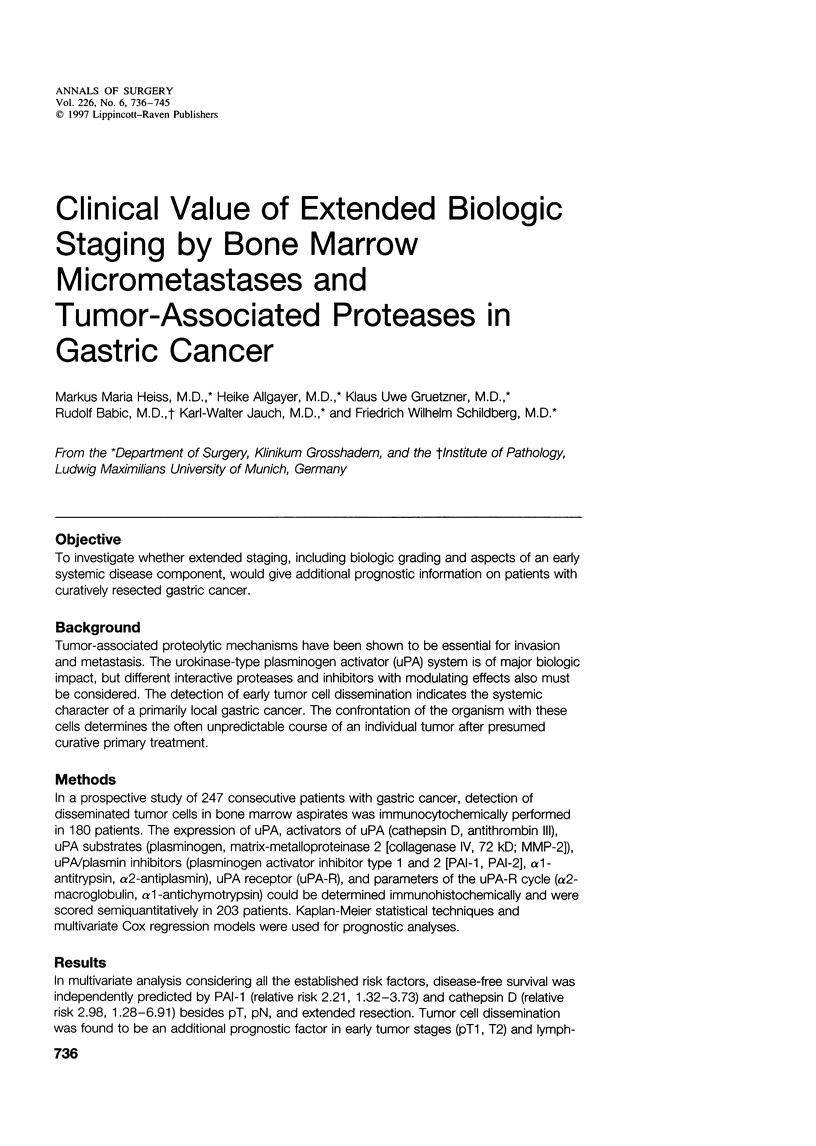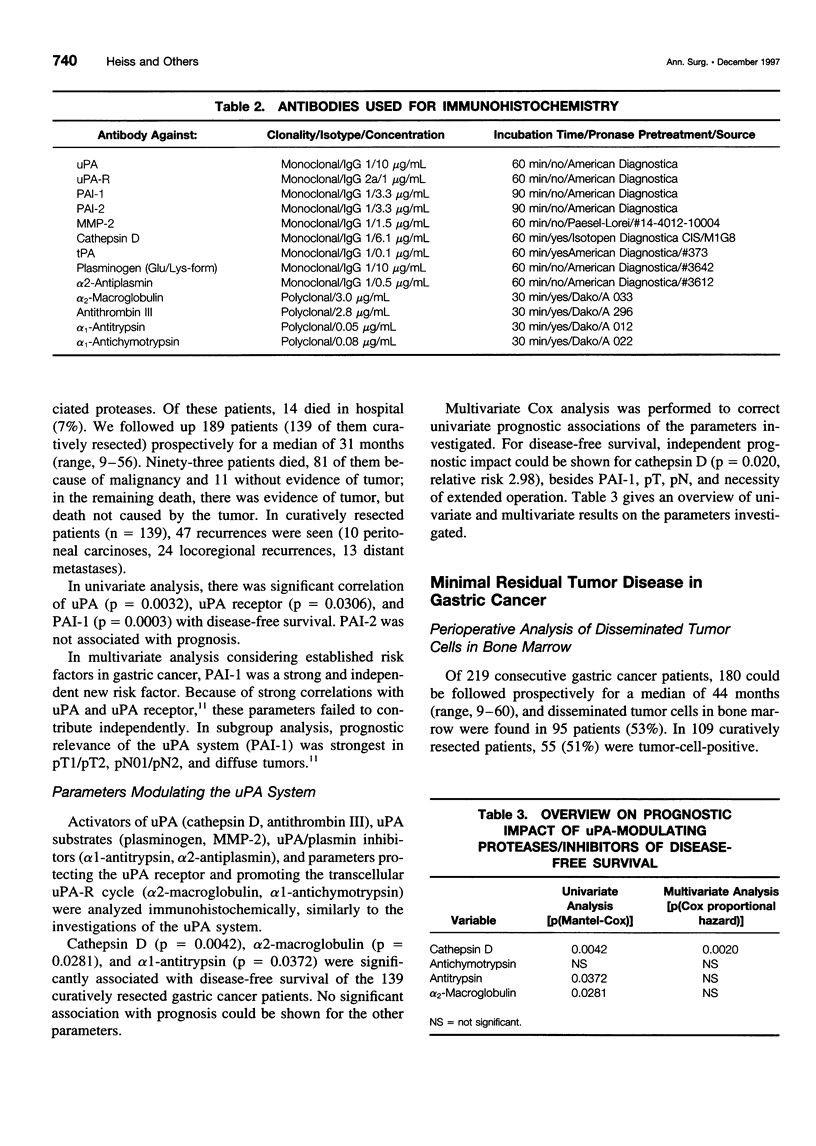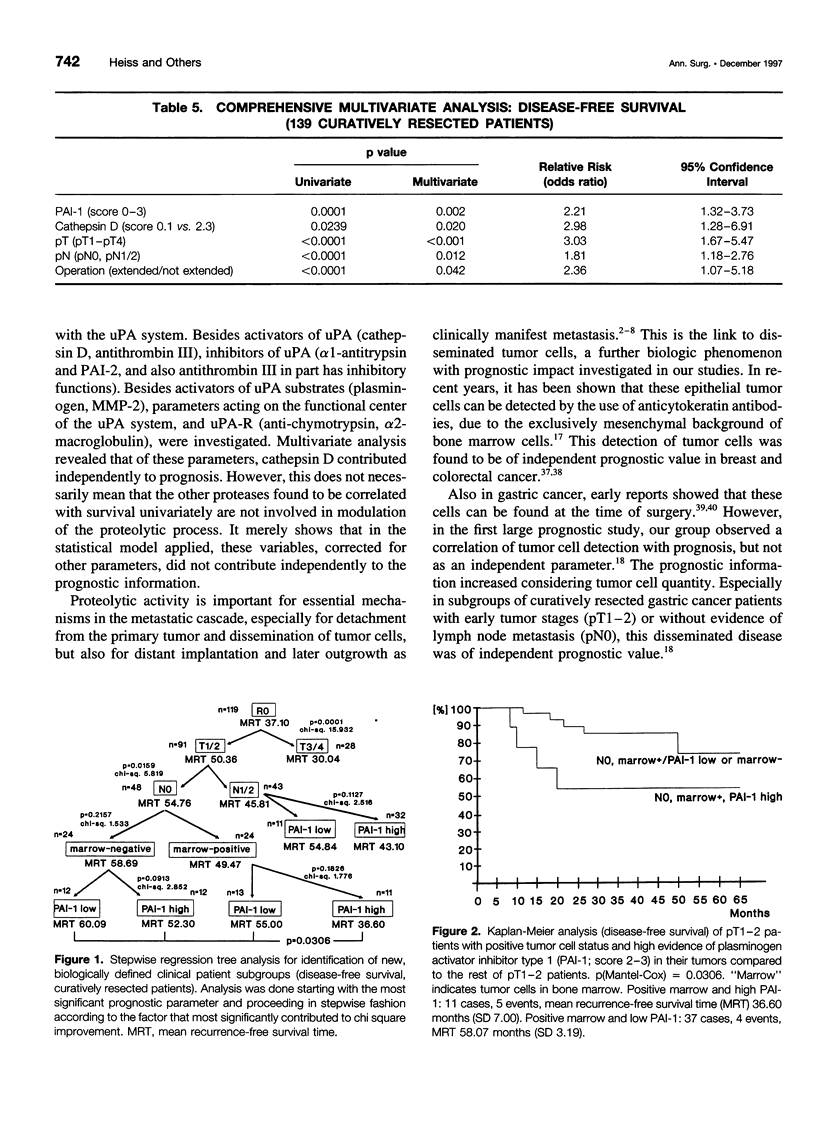Abstract
OBJECTIVE: To investigate whether extended staging, including biologic grading and aspects of an early systemic disease component, would give additional prognostic information on patients with curatively resected gastric cancer. BACKGROUND: Tumor-associated proteolytic mechanisms have been shown to be essential for invasion and metastasis. The urokinase-type plasminogen activator (uPA) system is of major biologic impact, but different interactive proteases and inhibitors with modulating effects also must be considered. The detection of early tumor cell dissemination indicates the systemic character of a primarily local gastric cancer. The confrontation of the organism with these cells determines the often unpredictable course of an individual tumor after presumed curative primary treatment. METHODS: In a prospective study of 247 consecutive patients with gastric cancer, detection of disseminated tumor cells in bone marrow aspirates was immunocytochemically performed in 180 patients. The expression of uPA, activators of uPA (cathepsin D, antithrombin III), uPA substrates (plasminogen, matrix-metalloproteinase 2 [collagenase IV, 72 kD; MMP-2]), uPA/plasmin inhibitors (plasminogen activator inhibitor type 1 and 2 [PAI-1, PAI-2], alpha1-antitrypsin, alpha2-antiplasmin), uPA receptor (uPA-R), and parameters of the uPA-R cycle (alpha2-macroglobulin, alpha1-antichymotrypsin) could be determined immunohistochemically and were scored semiquantitatively in 203 patients. Kaplan-Meier statistical techniques and multivariate Cox regression models were used for prognostic analyses. RESULTS: In multivariate analysis considering all the established risk factors, disease-free survival was independently predicted by PAI-1 (relative risk 2.21, 1.32-3.73) and cathepsin D (relative risk 2.98, 1.28-6.91) besides pT, pN, and extended resection. Tumor cell dissemination was found to be an additional prognostic factor in early tumor stages (pT1, T2) and lymphnode-negative patients. Stepwise regression analysis revealed an extended staging system with new risk groups. Node-positive, curatively resected pT1/2 patients with low expression of PAI-1 had a favorable prognosis (mean recurrence-free survival [MRT] 54.84 months), similar to that of node-negative patients (MRT 54.76 months). In node-negative, curatively resected pT1/2 patients, detection of bone marrow tumor cells and high expression of PAI-1 defined a subgroup with a steep decrease of prognosis (MRT 36.60 months), which was worse than that of node-positive patients (MRT 45.81). CONCLUSION: This new staging model gives better prognostic differentiation of subgroups, which should be considered in future adjuvant therapy protocols. In addition, it indicates that the uPA system might be a future therapeutic target.
Full text
PDF








Selected References
These references are in PubMed. This may not be the complete list of references from this article.
- Allgayer H., Heiss M. M., Riesenberg R., Grützner K. U., Tarabichi A., Babic R., Schildberg F. W. Urokinase plasminogen activator receptor (uPA-R): one potential characteristic of metastatic phenotypes in minimal residual tumor disease. Cancer Res. 1997 Apr 1;57(7):1394–1399. [PubMed] [Google Scholar]
- Blasi F. Urokinase and urokinase receptor: a paracrine/autocrine system regulating cell migration and invasiveness. Bioessays. 1993 Feb;15(2):105–111. doi: 10.1002/bies.950150206. [DOI] [PubMed] [Google Scholar]
- Brisco M. J., Condon J., Hughes E., Neoh S. H., Sykes P. J., Seshadri R., Toogood I., Waters K., Tauro G., Ekert H. Outcome prediction in childhood acute lymphoblastic leukaemia by molecular quantification of residual disease at the end of induction. Lancet. 1994 Jan 22;343(8891):196–200. doi: 10.1016/s0140-6736(94)90988-1. [DOI] [PubMed] [Google Scholar]
- Cordell J. L., Falini B., Erber W. N., Ghosh A. K., Abdulaziz Z., MacDonald S., Pulford K. A., Stein H., Mason D. Y. Immunoenzymatic labeling of monoclonal antibodies using immune complexes of alkaline phosphatase and monoclonal anti-alkaline phosphatase (APAAP complexes). J Histochem Cytochem. 1984 Feb;32(2):219–229. doi: 10.1177/32.2.6198355. [DOI] [PubMed] [Google Scholar]
- Diel I. J., Kaufmann M., Goerner R., Costa S. D., Kaul S., Bastert G. Detection of tumor cells in bone marrow of patients with primary breast cancer: a prognostic factor for distant metastasis. J Clin Oncol. 1992 Oct;10(10):1534–1539. doi: 10.1200/JCO.1992.10.10.1534. [DOI] [PubMed] [Google Scholar]
- Duffy M. J. The role of proteolytic enzymes in cancer invasion and metastasis. Clin Exp Metastasis. 1992 May;10(3):145–155. doi: 10.1007/BF00132746. [DOI] [PubMed] [Google Scholar]
- Dvorak H. F. Tumors: wounds that do not heal. Similarities between tumor stroma generation and wound healing. N Engl J Med. 1986 Dec 25;315(26):1650–1659. doi: 10.1056/NEJM198612253152606. [DOI] [PubMed] [Google Scholar]
- Gabbert H. E., Meier S., Gerharz C. D., Hommel G. Tumor-cell dissociation at the invasion front: a new prognostic parameter in gastric cancer patients. Int J Cancer. 1992 Jan 21;50(2):202–207. doi: 10.1002/ijc.2910500208. [DOI] [PubMed] [Google Scholar]
- Heiss M. M., Allgayer H., Gruetzner K. U., Funke I., Babic R., Jauch K. W., Schildberg F. W. Individual development and uPA-receptor expression of disseminated tumour cells in bone marrow: a reference to early systemic disease in solid cancer. Nat Med. 1995 Oct;1(10):1035–1039. doi: 10.1038/nm1095-1035. [DOI] [PubMed] [Google Scholar]
- Heiss M. M., Babic R., Allgayer H., Gruetzner K. U., Jauch K. W., Loehrs U., Schildberg F. W. Tumor-associated proteolysis and prognosis: new functional risk factors in gastric cancer defined by the urokinase-type plasminogen activator system. J Clin Oncol. 1995 Aug;13(8):2084–2093. doi: 10.1200/JCO.1995.13.8.2084. [DOI] [PubMed] [Google Scholar]
- Hermanek P. Prognostic factors in stomach cancer surgery. Eur J Surg Oncol. 1986 Sep;12(3):241–246. [PubMed] [Google Scholar]
- Ichinose A., Fujikawa K., Suyama T. The activation of pro-urokinase by plasma kallikrein and its inactivation by thrombin. J Biol Chem. 1986 Mar 15;261(8):3486–3489. [PubMed] [Google Scholar]
- Jauch K. W., Heiss M. M., Gruetzner U., Funke I., Pantel K., Babic R., Eissner H. J., Riethmueller G., Schildberg F. W. Prognostic significance of bone marrow micrometastases in patients with gastric cancer. J Clin Oncol. 1996 Jun;14(6):1810–1817. doi: 10.1200/JCO.1996.14.6.1810. [DOI] [PubMed] [Google Scholar]
- Juhl H., Stritzel M., Wroblewski A., Henne-Bruns D., Kremer B., Schmiegel W., Neumaier M., Wagener C., Schreiber H. W., Kalthoff H. Immunocytological detection of micrometastatic cells: comparative evaluation of findings in the peritoneal cavity and the bone marrow of gastric, colorectal and pancreatic cancer patients. Int J Cancer. 1994 May 1;57(3):330–335. doi: 10.1002/ijc.2910570307. [DOI] [PubMed] [Google Scholar]
- LAUREN P. THE TWO HISTOLOGICAL MAIN TYPES OF GASTRIC CARCINOMA: DIFFUSE AND SO-CALLED INTESTINAL-TYPE CARCINOMA. AN ATTEMPT AT A HISTO-CLINICAL CLASSIFICATION. Acta Pathol Microbiol Scand. 1965;64:31–49. doi: 10.1111/apm.1965.64.1.31. [DOI] [PubMed] [Google Scholar]
- Lindemann F., Schlimok G., Dirschedl P., Witte J., Riethmüller G. Prognostic significance of micrometastatic tumour cells in bone marrow of colorectal cancer patients. Lancet. 1992 Sep 19;340(8821):685–689. doi: 10.1016/0140-6736(92)92230-d. [DOI] [PubMed] [Google Scholar]
- Liotta L. A., Steeg P. S., Stetler-Stevenson W. G. Cancer metastasis and angiogenesis: an imbalance of positive and negative regulation. Cell. 1991 Jan 25;64(2):327–336. doi: 10.1016/0092-8674(91)90642-c. [DOI] [PubMed] [Google Scholar]
- Liotta L. A. Tumor invasion and metastases--role of the extracellular matrix: Rhoads Memorial Award lecture. Cancer Res. 1986 Jan;46(1):1–7. [PubMed] [Google Scholar]
- Ming S. C. Gastric carcinoma. A pathobiological classification. Cancer. 1977 Jun;39(6):2475–2485. doi: 10.1002/1097-0142(197706)39:6<2475::aid-cncr2820390626>3.0.co;2-l. [DOI] [PubMed] [Google Scholar]
- Møller L. B. Structure and function of the urokinase receptor. Blood Coagul Fibrinolysis. 1993 Apr;4(2):293–303. [PubMed] [Google Scholar]
- Nakane Y., Okamura S., Akehira K., Boku T., Okusa T., Tanaka K., Hioki K. Correlation of preoperative carcinoembryonic antigen levels and prognosis of gastric cancer patients. Cancer. 1994 Jun 1;73(11):2703–2708. doi: 10.1002/1097-0142(19940601)73:11<2703::aid-cncr2820731109>3.0.co;2-x. [DOI] [PubMed] [Google Scholar]
- Nekarda H., Schmitt M., Ulm K., Wenninger A., Vogelsang H., Becker K., Roder J. D., Fink U., Siewert J. R. Prognostic impact of urokinase-type plasminogen activator and its inhibitor PAI-1 in completely resected gastric cancer. Cancer Res. 1994 Jun 1;54(11):2900–2907. [PubMed] [Google Scholar]
- Ossowski L., Clunie G., Masucci M. T., Blasi F. In vivo paracrine interaction between urokinase and its receptor: effect on tumor cell invasion. J Cell Biol. 1991 Nov;115(4):1107–1112. doi: 10.1083/jcb.115.4.1107. [DOI] [PMC free article] [PubMed] [Google Scholar]
- Peto R., Pike M. C., Armitage P., Breslow N. E., Cox D. R., Howard S. V., Mantel N., McPherson K., Peto J., Smith P. G. Design and analysis of randomized clinical trials requiring prolonged observation of each patient. II. analysis and examples. Br J Cancer. 1977 Jan;35(1):1–39. doi: 10.1038/bjc.1977.1. [DOI] [PMC free article] [PubMed] [Google Scholar]
- Riethmüller G., Johnson J. P. Monoclonal antibodies in the detection and therapy of micrometastatic epithelial cancers. Curr Opin Immunol. 1992 Oct;4(5):647–655. doi: 10.1016/0952-7915(92)90041-c. [DOI] [PubMed] [Google Scholar]
- Schlimok G., Funke I., Pantel K., Strobel F., Lindemann F., Witte J., Riethmüller G. Micrometastatic tumour cells in bone marrow of patients with gastric cancer: methodological aspects of detection and prognostic significance. Eur J Cancer. 1991;27(11):1461–1465. doi: 10.1016/0277-5379(91)90032-9. [DOI] [PubMed] [Google Scholar]
- Schwartz G. K., Wang H., Lampen N., Altorki N., Kelsen D., Albino A. P. Defining the invasive phenotype of proximal gastric cancer cells. Cancer. 1994 Jan 1;73(1):22–27. doi: 10.1002/1097-0142(19940101)73:1<22::aid-cncr2820730106>3.0.co;2-o. [DOI] [PubMed] [Google Scholar]
- Shiu M. H., Perrotti M., Brennan M. F. Adenocarcinoma of the stomach: a multivariate analysis of clinical, pathologic and treatment factors. Hepatogastroenterology. 1989 Feb;36(1):7–12. [PubMed] [Google Scholar]
- Straight D. L., Hassett M. A., McKee P. A. Structural and functional characterization of the inhibition of urokinase by alpha 2-macroglobulin. Biochemistry. 1985 Jul 16;24(15):3902–3907. doi: 10.1021/bi00336a014. [DOI] [PubMed] [Google Scholar]


